First World War Project
Frederick Walter WILES (of Lynsted)
b. April 1891 Acting Colour Sergeant, Service Number 511340 (formerly 4840) |
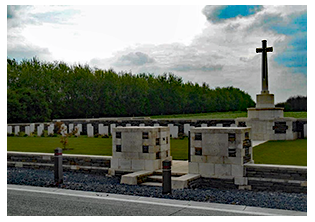

Born in April 1891 in 3 Claxfield Villas, Greenstreet, Lynsted, Frederick was one of the six children of Walter Edward, a hay trusser, and Annie Elizabeth (née Woolett). Frederick had four older sisters: Rosetta Eliza, Edith Elizabeth, Mabel Gertrude, Lillian Mary, and a younger brother, George Albert. Frederick was christened in Teynham church on 13 May 1891.
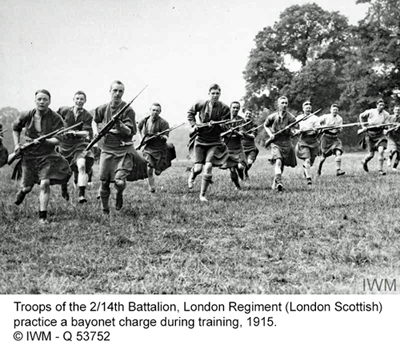 At the time of the 1911 census, Frederick was working as a hotel porter at 95 Dover Street, Folkestone. However, by December 1914 he had enlisted in London into the 2/14th (2nd London Scottish) Battalion.
At the time of the 1911 census, Frederick was working as a hotel porter at 95 Dover Street, Folkestone. However, by December 1914 he had enlisted in London into the 2/14th (2nd London Scottish) Battalion.
Frederick's service papers are sadly unavailable, which is frustrating given that he obviously showed potential. What we do know is that the Battalion in which he served was a territorial unit formed in London in September 1914. Just a month after his enlistment the Battalion moved to Dorking to join the 179th Brigade of the 60th Division.
In April 1915 they moved to Watford, then on to Saffron Walden in June. In January 1916 the unit arrived in Sutton Veny, Wiltshire, where they were prepared for overseas service.
The Battalion's embarkation to France was planned for April 1916, but was postponed due to the Easter Rising in Ireland. On 28 April they arrived in Cork for security duties in Ireland. For 2 weeks they were based in Ballincollig and Macroom.
On 14 May 1916, the Battalions returned to Sutton Veny before embarking for France on 21 June. The few records that we have seen state that Frederick was "acting colour sergeant".
By the end of June, Frederick's battalion was in Maroeuil, North West of Arras. The next four months would see them alternating between time in the trenches at Ecoivres and rest periods in Bray.
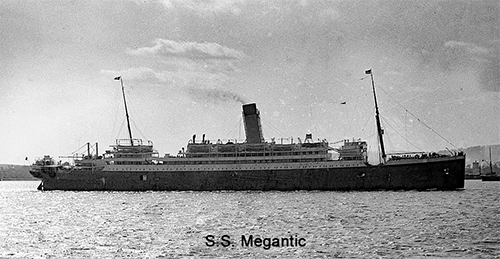 Their journey through France to Marseilles began on 26 October 1916. By the end of November they embarked for Salonika, via Malta, on the SS Megantic. This ship was made famous as the vessel that carried the infamous murderer, Dr Crippen, back to England after his arrest in Canada in 1910.
Their journey through France to Marseilles began on 26 October 1916. By the end of November they embarked for Salonika, via Malta, on the SS Megantic. This ship was made famous as the vessel that carried the infamous murderer, Dr Crippen, back to England after his arrest in Canada in 1910.
By 30 November Frederick and his comrades were encamped in Salonika.
At the time of writing, the Battalion War Diaries had not been digitised for 1917 and the period of their return to France in June 1918. However, we do know the battles in which the Battalion were involved.
From 22 April 1917 to 8 May 1917, Frederick's battalion was in action during the Battle of Doiran. The battle's aim was to make a major breakthrough in the Balkans. Despite the non-appearance of promised reinforcements on what was to be the final day of the battle, the allied forces made a final and ultimately unsuccessful push. In all, 12,000 men killed, wounded or captured. The Bulgarians reported they had buried 2,250 of our casualties. Perhaps not surprisingly, the British named the scene of the battle as "the valley of death".
In this theatre of war, falling victim to disease was not unusual. It is known that, following the action at Doiran, Frederick was hospitalised with trench fever. He was firstly sent to 28 Casualty Clearing Station in Karasouli and then transferred to the No.3 Convalescent Depot, Orendzik, on 30 May. The hospital records list Frederick's rank as the Company Quartermaster. He was discharged back to duty on 15 June.
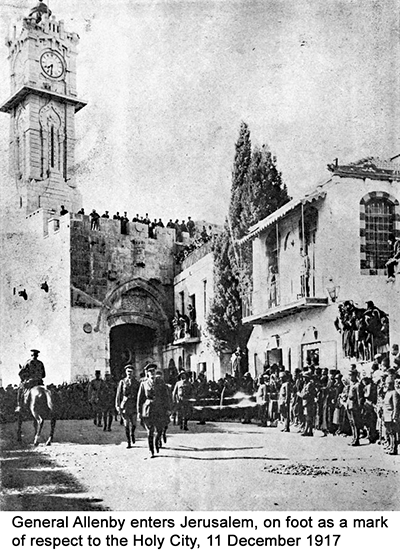 On 30 June 1917, the Battalion was moved to Alexandria from where they would engage in various actions as part of the Palestine Campaign: firstly, the Third Battle of Gaza, fought between British and Ottoman forces during the Sinai and Palestine Campaign on 1 - 2 November 1917.
On 30 June 1917, the Battalion was moved to Alexandria from where they would engage in various actions as part of the Palestine Campaign: firstly, the Third Battle of Gaza, fought between British and Ottoman forces during the Sinai and Palestine Campaign on 1 - 2 November 1917.
The battalion also played a key role in the Battle of Jerusalem between 17 and 30 December 1917. Although Jerusalem was captured by the Allies on 9 December 1917, the fight continued in defence of the city. The allied defences in the north of the city were weak.
General Allenby ordered a new offensive to push the Turkish forces back by a further 10 miles. This was planned for 24 December but postponed due to poor weather. The British intercepted a radio message that forewarned them that the Turkish troops were planning an attack for the 26/27 December. With this forewarning, the Turkish forces were unable to make any progress against the now prepared British troops. The Turkish resistance faded and on 30 December the British gained their objective.
Such was their success, the allied forces had advanced quicker than their supply-lines could maintain - no doubt making Frederick's job as acting company quartermaster a very difficult one. Heavy rains meant that ground conditions were poor, so time was now taken to regroup.
The beginning of 1918 saw the battalion taking part in the Capture of Jericho, fought between 19 and 21 February with the aim of occupying the Jordan Valley. The area was bordered by the Bethlehem–Nablus road in the west, the Jordan River in the east, and north of a line from Jerusalem to the Dead Sea.
Still pushing forward, the allies took part in the Battle of Tell 'Asur between 8 and 12 March 1918, with fighting taking place from the Mediterranean to Abu Tellul and Mussalabeh.
Following the allied success, the First Attack on Amman took place between 21 March and 2 April 1918. Here Frederick's battalion was in support of the Anzac Mounted Division and the Imperial Camel Corps Brigade (fighting dismounted as infantry). This action was not a success and was followed by a second attack fought east of the Jordan River between 30 April and 4 May 1918. Again the Ottoman counterattacked, forcing the allied forces to withdraw to the Jordan Valley. This would continue to be occupied by the troops of the Egyptian Expeditionary Force through the summer until the middle of September 1918, when the Battle of Megiddo began.
For Frederick, however, the time was coming when his battalion would be called to France. Preparation for this move is detailed in the battalion's war diary:
| Date | Summary events and Information |
| 1st-4th June 1918 |
In the Field: KANTARA: Training. Company training. Specialist Classes – signalling, scouts and snipers, Lewis Gun and R.S.M.'s classes. Bathing in Canal. |
| 15th June | Battalion entrained KANTARA 17.00 hours. Left KANTARA 18.40 hrs. |
| 16th June | Arrived ALEXANDRIA 03.15 hours. Embarked on H.M.T. CANBERRA 0800 hours. |
| 17th June | Remained on board H.M.T. CANBERRA. Physical drill, Lewis Gun and Musketry Training Carried out. |
| 18th June | Left ALEXANDRIA 1700 hours |
| 19th-21st June |
At sea. Arrived TARANTO [Southern Italy] 1200 hours (21st inst) at 1800 hours proceeded into inner harbour. Remained on board during night (21-22). |
| 22nd June | Battalion disembarked and proceeded to CIMINO Rest Camp TARANTO. 23rd June: Physical Training and Bathing. |
| 24th-30th June | Entrained at CIMINO. Travelling until arrival at "US MARINES SERQUEUX NOYELLE" |
On 2 July 1918 the battalion was transferred to the 90th Infantry Brigade of the 30th Division.
It is known that around this time Frederick was able to come home on leave. It would be for the last time.
July 1918 found the battalion in Serques, Pas de Calais, undergoing intensive training while in reserve. On the 29 July they were back in the field.
The battalion war diary details Frederick's final three weeks:
| Date | Summary events and Information |
| 1st August 1918 | In the Field: Battalion in the Line Right sub-sector LOCRE Sector with H.Q. at M.27.b.7.3. "A" Company on Right; "C" Company Right Centre; "B" Company Left Centre and "D" Company Left Company. Casualties from enemy shelling and Machine Gun fire 5 killed and 9 wounded. Battalion was relieved by 2/16th Battalion London Regiment (Queens Westminsters) and proceeded in Reserve area with HQ at R.2.d.1.0. [BERTHEN (1/10,000)]. |
| 2nd August | [LOCRE 1/10,000]: In billets and bivouacs in Reserve Area |
| 3rd August | [BERTHEN 1/10,000]: Battalion proceeded to Bivouac Area at EECKE. |
| 4th August | Church Parades in morning. |
| 5th-6th August | Companies under Company Commanders for training in morning. Specialists training in afternoon |
| 7th August | Companies under Company commanders in morning. C.O. (Major Whyte, M.C.) inspected "A" and "C" Companies in full marching order, and Band in Fighting order in afternoon. |
| 8th August | [NETEREN, 1/10,000]: Company under Company Commanders in morning. Battalion moved in evening with Brigade into Divisional Reserve at R.9.a.4.5 (Sheet 27 Eastern Half). "C" Echelon detachment proceed to Divisional Reception Camp at ARNEKE Western. |
| 9th-11th August | Training under Company Commanders and Specialist Training including Lewis Gun, Signalling, Scouts, Stretcher-bearers, and Range Finding Classes. |
| 12th August | 9.0 a.m.: Bathing was in progress during morning until 12.30. During afternoon, Lewis Gun firing was carried out, Range Finding class & S.B. Class trained during afternoon. Signalling Class under Squadron Sergeant trained from 8–11 a.m. & 2–4. |
| 13th August | 9 – 11 & 2 - 4: Companies under Company Commanders for intensive digging and practice in the attack. Signallers & Lewis Gun classes as yesterday. |
| 14th August | 9 – 11: Companies under Company Commanders for intensive digging and practice in the attack. Battalion moved to relieve 1/6 Cheshires in the line at LOCREHOF SECTOR. M.29.b.1.1. |
| 15th August | Battalion in Front Line |
| 16th August | Battalion in Front Line. During night Battalion was relieved in the line into SUPPORT with H.Q. at M.22.a.4.5. |
| 17th August | Battalion was relieved in SUPPORT line by 2/16th London Regiment and moved back into Brigade Reserve. |
| 18th August | Battalion practised attack twice during day and once by night at MOTH FARM. (R.8.c.90.55). |
| 19th August | Companies under Company Commanders for intensive digging and wiring. Battalion moved up into SUPPORT behind MONT ROUGE (M.22a) at 9 p.m. relieving 2/15th London Regiment. Casualties from shelling – 1 killed, 1 Died of Wounds. [KEMMEL Sheet 28.SW.1] |
| 20th August | Corp moved into assembly positions for attack about 10 p.m. taking over front line from 2/16th London Regiment. |
| 21st August | In the Field |
The account of the operations that took place on the day that Frederick lost his life is detailed in the following report:
Battalion moved from support line to position of assembly on night 20/21st August 1918 and were all in position by 12.40 midnight. The barrage fell at zero 2.5 a.m., and the battalion advanced under this heavy barrage and cover of a thick mist. WAKEFIELD WOOD proved a considerable obstacle but was overcome owing to excellence and pace of the artillery barrage. It, however, caused the formations to break up, but section leaders were able to reform on the far side of the wood. All objectives were gained by 3 a.m.
Consolidation was commenced but owing to the fact that the right flank was in the air, it was pulled back to conform with the South Lancs Regiment on the right. The Pioneers 6th S.W.B. aided materially in the work of consolidation. Wire was erected in front of support line and also in front of Right Companies front line, but owing to lack of time it was not formidable. Just before the mist lifted, the enemy pressed forward from the direction of DRANOUTRE, and advanced to counter attack. "A" Company's covering party were ordered to withdraw at apparently the same time as the counter attack took place, but this was not known when they were ordered to withdraw, and the Lewis Gunner remaining to cover the withdrawal was killed. At the same time the enemy made a formidable counter attack from RUMBOLD FARM to LOCREHOF FARM. The withdrawal of "A" Company's covering party left the right flank of "B" Company in the air and enfiladed by the enemy's attack they together with our Left Post fell back fighting on LOCREHOF FARM, but owing to mist and the unrecognisable condition of the farm itself, fell back past the farm to about M.29.d.00.55. on the corner of the long strip of water in M.29.d.30.50. The enemy rushed in considerable force LOCREHOF FARM causing the Right Post of "C" Company to withdraw from the Southern Edge of LOCREHOF POND, establishing himself with a considerable number of Machine Guns in the farm which was then in the air, at the same time attacking along the hedges in M.29.d.80.80. They succeeded in killing or wounding the post and seizing the Lewis Gun. O.C. "C" Company, Lieut. S.E. JONES immediately counter attacked and cleared the Farm, capturing 5 Machine Guns and reached his original Right Post again arriving there with a Sergeant and three men. They came under heavy Machine Gun fire from about M.29.d.80.50 and had to withdraw taking with them their Lewis Gun. The post, however, about M.29.d.45.45 was maintained all day under Corporal DAVIS who was subsequently wounded.
Broad daylight came suddenly, the mist clearing away, the whole area being under direct observation from KEMMEL thus making movement impossible. During the day 21st August enemy shelling on our line was intermittent. From 10.15 p.m. night 21/22nd the enemy shelled the whole area heavily using a large proportion of gas shells (BLUE and GREEN CROSS) particularly WAKEFIELD WOOD which affected carrying parties at about midnight the enemy attacked "A" Company and the S. LANCS on the right. Right Post of "A" Company in conjunction with Left Post S.LANCS repulsed the attack. Enemy succeeded in bombing our next two Posts S. LANCS and established a machine gun at the corner of the fence at about M.35.b.05.70. "A" Company threw back a defensive flank and again got touch with S.LANCS but owing to the machine gun and its supporting troops was unable to aid in ejecting the enemy occupying these posts. On the Left Flank whilst this was going on "C" Company reached a hostile machine gun which had established itself at M.29.d.02.50 killing some of the crew including an officer, but the gun itself was not taken. During 22nd, shelling in support line was fairly heavy. On the night 22/23rd, "C" Company sent out a patrol of 1 Officer and 20 men to re-establish themselves in the Post Line East of LOCREHOF FARM but no sooner was the necessary reconnaissance made than the enemy put down a smoke and gas shell bombardment, under cover of which the enemy re-occupied the farm. During the evening Lewis Gun Posts were pushed out to about M.29.d.01.30 and M.29.c.99.05. In the early hours of the morning the battalion was relieved by 1/15th London Regiment and moved back into support behind MONT ROUGE.
The casualties during this action were:
Officers Other Ranks Killed 2 27 Wounded 4 89 Wounded (gassed) 1 18 Missing 0 5 Wounded at duty 0 13 Accidentally injured 1 0 Prisoners taken 2 70 War Material captured 5 Heavy Machine Guns 13 Light Machine Guns
After 3 years and 9 months of service, and just before he was due to return home to England to take up officer training, Frederick was killed in action. His death was announced locally:
| Faversham and North East Kent News of 16th November 1918 |
TWO LYNSTED MEN We regret to announce the deaths of two more men connected with Lynsted parish, namely Sergt. Frederick Walter Wiles, London Scottish, and Lance-Corporal Charles Booker S.W.B. Sergeant Wiles, after serving in Palestine transferred this year to France where he was killed in action on Mount Kemmel on August 21st. Only a few weeks previously he had been home on leave, and he was shortly to come home again to train for a commission………... |
Frederick is buried in Locre No 10 Cemetery, Heuvelland, West-Vlaanderen, Belgium, Grave Ref: B.3. Locre cemetery has both Commonwealth and German dead buried in its grounds. The bodies were retrieved from the battlefields after the signing of the Armistice on Monday 11 November 1918.
In November 1918, Frederick's mother received two payments of money owed: one for £7 6s 7d (£7.33p) and another for 7/6d (62½p). In February 1920 she received his War Gratuity of £17 10s (£17.50p). [See Appendix 2] Taken together these amount to roughly £1,300 in today's money.
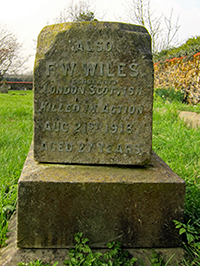 Just 4 months after Frederick's death, on 30 December 1918, his father died. Frederick is remembered on his grave in Lynsted Churchyard extension.
Just 4 months after Frederick's death, on 30 December 1918, his father died. Frederick is remembered on his grave in Lynsted Churchyard extension.
In 1918, Frederick's younger brother Private, 270212, George Albert Wiles, whilst serving in The Buffs (East Kent Regiment), was awarded the Military Medal. Formerly a member of the 1/1st Royal East Kent Yeomanry, (The Duke of Connaught's Own (Mounted Rifles), George had been posted to the Balkan war theatre on Friday 24 September 1915. He was awarded the Military Medal for gallantry and devotion to duty while acting as a stretcher bearer for many hours under heavy shell fire. Thankfully, George survived the carnage of the Great War and was demobilised on Sunday 23 March 1919.
On the anniversary of his death, Frederick was remembered by his family:
| East Kent Gazette of 23rd August 1919 |
IN MEMORIAM WILES. In loving memory of Frederick Walter Wiles, killed in action, in France, August 21st, 1918, aged 28 [sic] years.
|

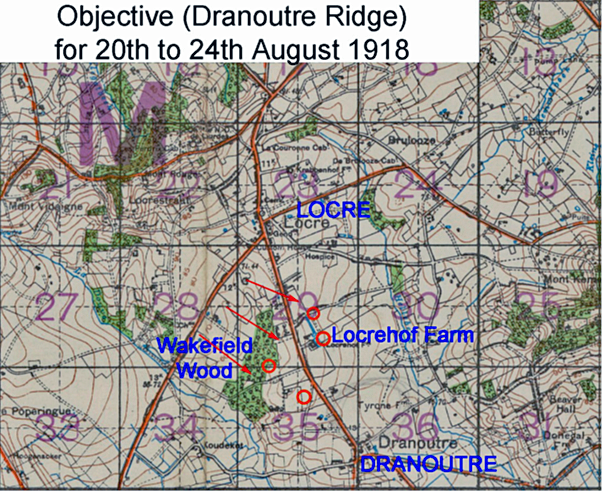
 World War 1 Pages
World War 1 Pages